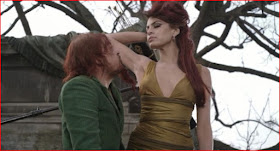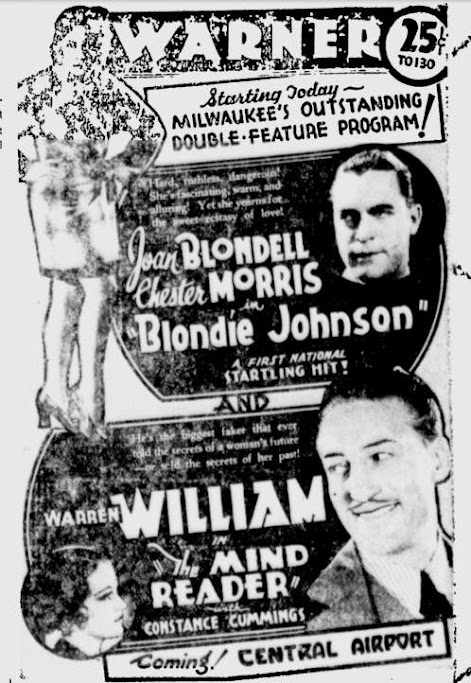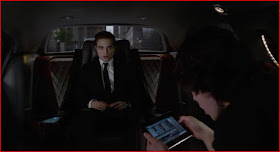 A
A man has strange adventures while riding through the city in a stretch limousine. Sound familiar? The French director Leos Carax claims no inspiration from Don DeLillo's novel
Cosmopolis, but Carax's
Holy Motors succeeds where David Cronenberg's adaptation of
Cosmopolis failed in creating a cinematically alien world in which the literary language of an artistic novel might seem natural rather than stiff or affected. Since
Holy Motors is mostly in French, I can't tell if Carax's dialogue is stiff the way Cronenberg's was, and to be fair literary dialogue isn't one of Carax's priorities. Some of
Holy Motors' episodes are silent, and one is an outright homage to silent comedy. But Carax uses sight and sound (including music prominently) to create mood and atmosphere in a way Cronenberg, admittedly handicapped by very dry source material, couldn't manage. The two films will be linked for a long time -- they finished one and two, Carax over Cronenberg, in
Cahiers du Cinema's Best of 2012 survey -- but they're arguably fundamental opposites.
Cosmopolis is introverted; the world comes to Robert Pattinson's limo while he ventures out only occasionally.
Holy Motors is extroverted; Oscar (Denis Lavant) isn't on a joyride in search of a haircut but on a schedule, his driver Celine (Edith Scob) ferrying him to several "appointments" over the course of a trying day.
Cosmopolis is a mordant commentary on the way we live now that probably couldn't help looking simplistically pretentious (the poor man just wants to
feel something!) on film.
Holy Motors quickly reveals itself as a wild fantasy that somehow still rings true in uncanny ways. In the simplest terms,
Cosmopolis is a mostly failed effort (
Cahiers notwithstanding) to turn a work of literary into film, while
Holy Motors is a pure work of cinematic art.
Holy Motors provides limo services with amenities.
Below, Denis Lavant takes advantage of the bar
while Edith Scob keeps her eyes on the road.
More importantly,
Cosmopolis is a statement while
Holy Motors is a dream. It's the latest reassertion of the "dream logic" that defines much of European cinema, whether "art" or "genre." Some observers may amuse themselves wondering
whose dream the film is. For a while during the film, you might take it for something bigger, more fantastical than a mere dream. I could see people speculating that Oscar is some sort of angel, as are the other people driven through Paris in the white limos based at the Holy Motors garage revealed at the end of the picture. His appointments aren't the usual meetings or chores. Oscar himself is a makeup artist, working up his transformations in the limo, turning himself into a begging bag lady, a dying old man, a dad with a teenage daughter, and a barefoot wildman character Levant has played for Carax before. Oscar could well be Andy Serkis, reporting to a film studio to shoot a motion-capture fight scene, followed by a sinuous dance with a tall, limber actress (see the poster), simulating the coupling of CGI monsters.
As the wild man Oscar is Chaplinesque and Chaneyesque at once, invading a fashion photoshoot in a cemetery (scored to Akira Ikufube's
Godzilla theme!) and dragging Eva Mendes to the sewer, where he eats her money and her wig and transforms her
haute couture costume into a burka before arranging her and himself into a
pieta pose.


But there are strong hints of a more troubled inner life, especially a mournful encounter with a similarly-"employed" woman (Kylie Minogue) who sings "Who Were We?" (perhaps the best movie song of the year) and whose "appointment" includes jumping off a building. Oscar smokes and drinks more insistently as the day winds down, while Celine gently urges him to eat. And some things happen to him that just can't happen. As a gangster, Oscar assassinates a man, then makes the victim up to look like himself, albeit in his current mustachioed guise. Then the victim stabs Oscar in the neck and escapes as our hero bleeds out. But it's still Oscar, presumably, who attempts another assassination (a banker this time) only to get shot to hell ("Aim for the crotch!" he urges) before Celine retrieves him with apologies to bystanders for the mistake. And he's fine, apart from the coughing, smoking and drinking, by the time for the next appointment. It makes sense if he's some kind of supernatural creature, or if all these incidents are just the dreams of one night.


Once Celine delivers Oscar to his own home for his last appointment of the night you may be satisfied that it was all dreams. But Carax isn't interested in any conceptual closure. In the last few minutes he hits us with more surprises, some of which may infuriate viewers and all of which warn us that the dream isn't over, and may never end. The only one I'll spoil, since it's an almost predictable sop to movie buffs, is the moment when Edith Scob symbolically resumes
her established place in movie history -- which itself might have been a signal (the character yielding to the actress) that the dream is over, except for what comes after. By the time it's over you may decide that Carax doesn't know when to quit -- the film certainly does end with a WTF moment -- but
Holy Motors is the sort of film that
shouldn't know when to quit. Restraint is no more a priority than coherence. The movie isn't a puzzle to solve; there needn't be an answer to what we're seeing to justify the spectacle.
Holy Motors thrives on suggestion, on evocation rather than assertion. If it's narrative or nothing for you, this may be worse than nothing. But cinema is almost always spectacle, and often the image is the subconscious of the word. Carax's movie is almost exclusively subconscious, but it's also one of the funnier, more poignant and most inventive pictures I've seen from 2012, and one of that year's best films. It was Carax's first feature film in 13 years -- a fact that makes you wish he could get more busy like Terrence Malick or Manoel de Oliveira. Carax is only 52 but he's got a lot of catching up to do.







 P
P





 Y
Y W
W T
T F
F A
A










 T
T M
M








 T
T
 I
I




 N
N




